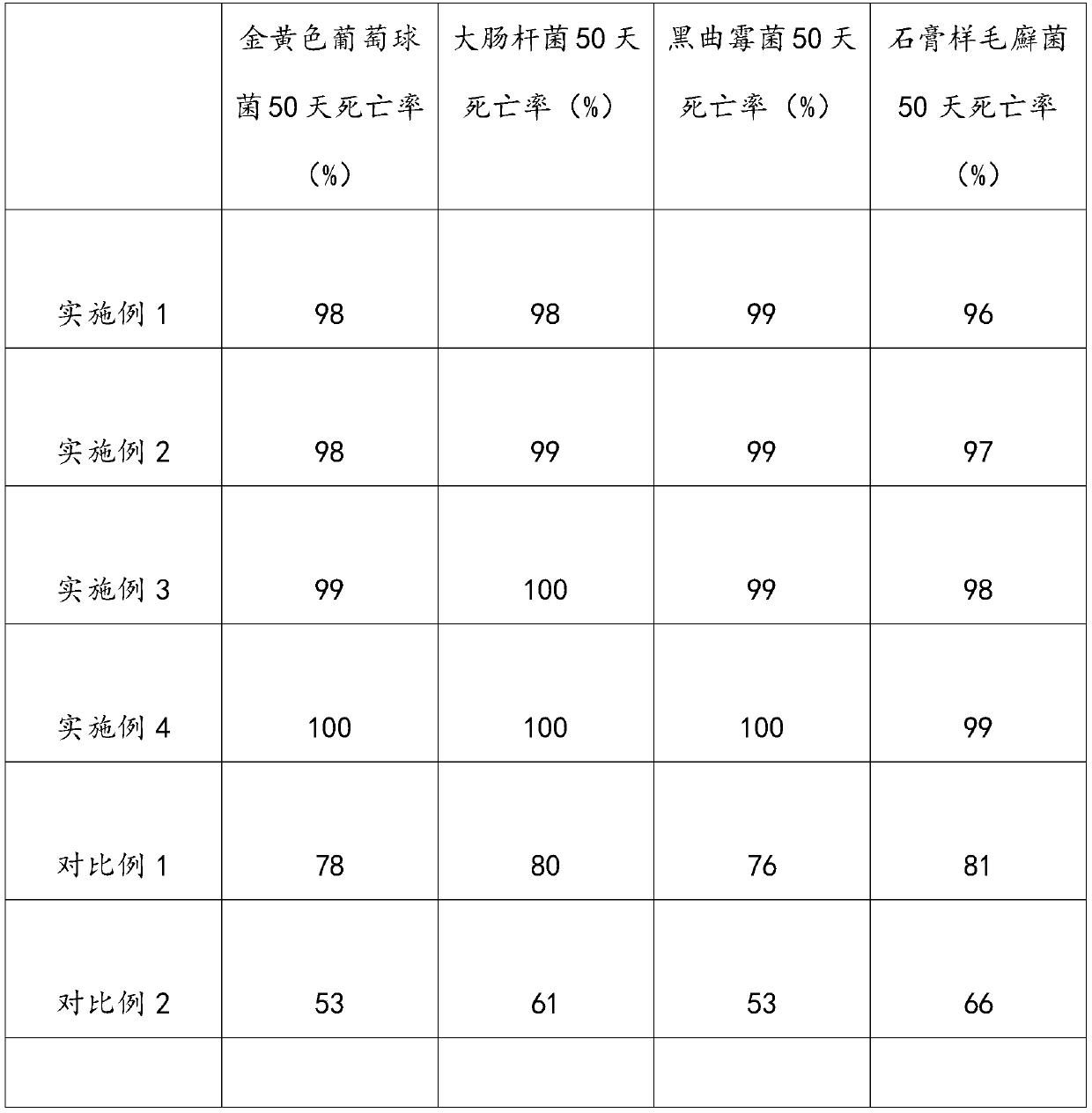Preparation method of antibacterial textile material
A technology of textile materials and raw materials, which is applied in the field of preparation of antibacterial textile materials, can solve the problems that the antibacterial textile materials cannot fit human skin, and the antibacterial effect of antibacterial textile materials is not excellent, and achieves good mechanical strength and chemical stability, and enhances sterilization performance. The effect of durability improvement
- Summary
- Abstract
- Description
- Claims
- Application Information
AI Technical Summary
Problems solved by technology
Method used
Image
Examples
Embodiment 1
[0029] A preparation method of antibacterial textile material includes the following steps:
[0030] Step S1. Weigh the following raw materials: 55 parts by weight of modified polyacrylonitrile fiber, 25 parts of chitin / montmorillonite composite fiber, 15 parts of sodium tripolyphosphate, 15 parts of butyl orthosilicate, 5 parts of triphosphite Phenyl ester, 10 parts of phthalic diallyl resin, 75 parts of deionized water;
[0031] Step S2. Solvent preparation: Pour 5% potassium permanganate aqueous solution into the beaker, then sequentially add siloxane and borate into the beaker, stir at a constant speed for 5 minutes to prepare the solvent, and control the potassium permanganate aqueous solution and silica The weight ratio of alkane to boric acid ester is 3:2:1;
[0032] Step S3, preparing modified polyacrylonitrile fiber:
[0033] (1) Add the polyacrylonitrile resin to the solvent prepared in step S2, stir at a constant speed for 15 minutes, after the polyacrylonitrile resin is d...
Embodiment 2
[0039] A preparation method of antibacterial textile material includes the following steps:
[0040] Step S1. Weigh the following raw materials: 60 parts by weight of modified polyacrylonitrile fiber, 28 parts of chitin / montmorillonite composite fiber, 18 parts of sodium tripolyphosphate, 16 parts of butyl orthosilicate, 8 parts of triphosphite Phenyl ester, 12 parts of phthalic diallyl resin, 80 parts of deionized water;
[0041] Step S2. Solvent preparation: Pour 5% potassium permanganate aqueous solution into the beaker, then sequentially add siloxane and borate into the beaker, stir at a constant speed for 5 minutes to prepare the solvent, and control the potassium permanganate aqueous solution and silica The weight ratio of alkane to boric acid ester is 3:2:1;
[0042] Step S3, preparing modified polyacrylonitrile fiber:
[0043] (1) Add the polyacrylonitrile resin to the solvent prepared in step S2, stir at a constant speed for 15 minutes, after the polyacrylonitrile resin is d...
Embodiment 3
[0049] A preparation method of antibacterial textile material includes the following steps:
[0050] Step S1. Weigh the following raw materials: 70 parts by weight of modified polyacrylonitrile fiber, 32 parts of chitin / montmorillonite composite fiber, 25 parts of sodium tripolyphosphate, 18 parts of butyl orthosilicate, 12 parts of triphosphite Phenyl ester, 17 parts of phthalic diallyl resin, 90 parts of deionized water;
[0051] Step S2. Solvent preparation: Pour 5% potassium permanganate aqueous solution into the beaker, then sequentially add siloxane and borate into the beaker, stir at a constant speed for 5 minutes to prepare the solvent, and control the potassium permanganate aqueous solution and silica The weight ratio of alkane to boric acid ester is 3:2:1;
[0052] Step S3, preparing modified polyacrylonitrile fiber:
[0053] (1) Add the polyacrylonitrile resin to the solvent prepared in step S2, stir at a constant speed for 15 minutes, after the polyacrylonitrile resin is ...
PUM
 Login to View More
Login to View More Abstract
Description
Claims
Application Information
 Login to View More
Login to View More - R&D
- Intellectual Property
- Life Sciences
- Materials
- Tech Scout
- Unparalleled Data Quality
- Higher Quality Content
- 60% Fewer Hallucinations
Browse by: Latest US Patents, China's latest patents, Technical Efficacy Thesaurus, Application Domain, Technology Topic, Popular Technical Reports.
© 2025 PatSnap. All rights reserved.Legal|Privacy policy|Modern Slavery Act Transparency Statement|Sitemap|About US| Contact US: help@patsnap.com


